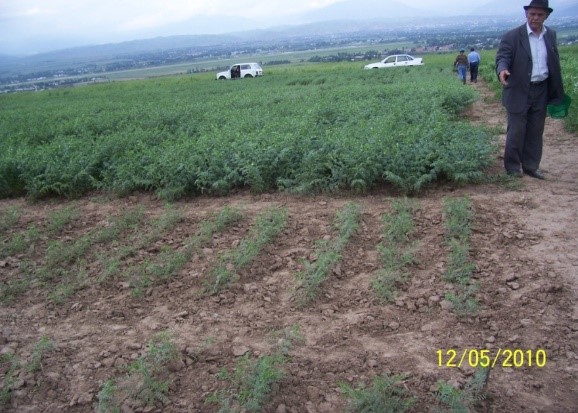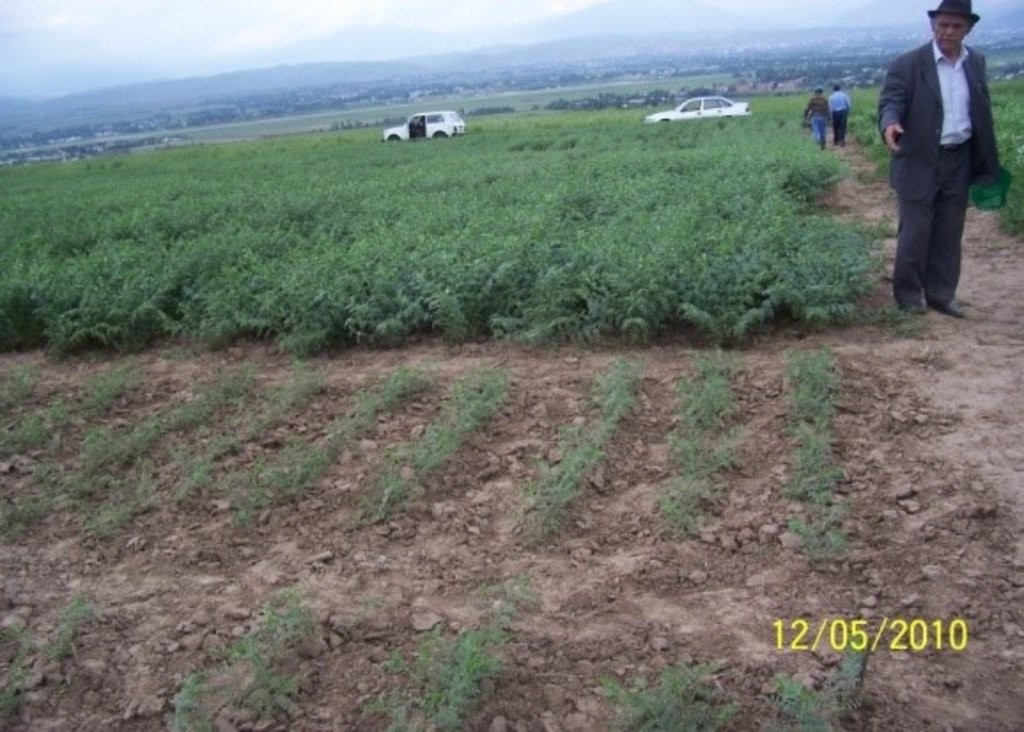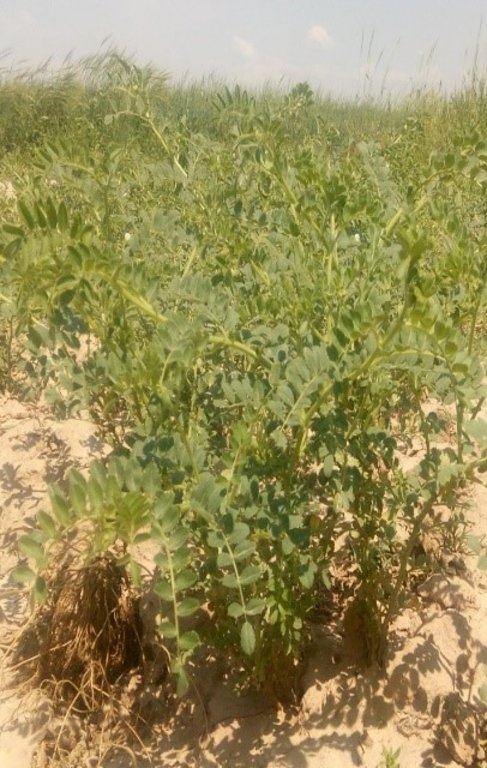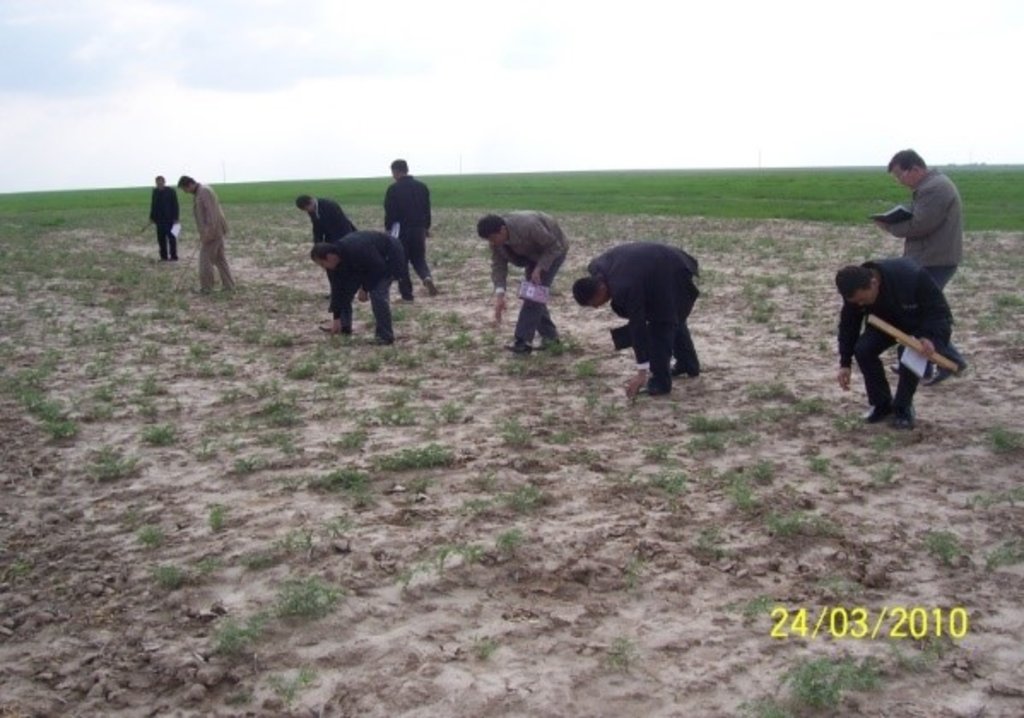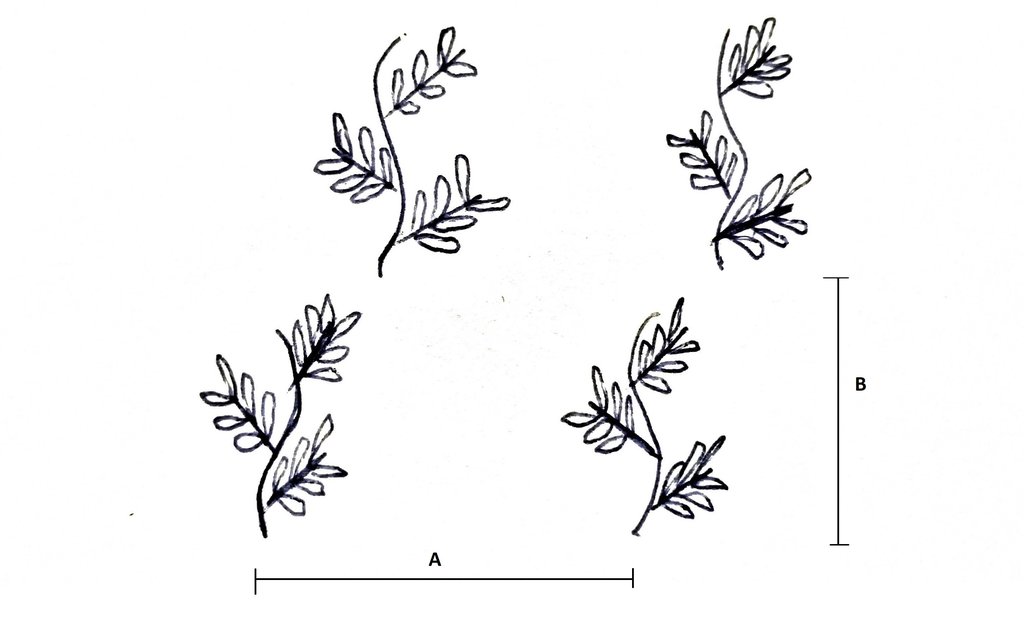Winter Chickpea Planting in Cold Dry Areas [乌兹别克斯坦]
- 创建:
- 更新:
- 编制者: Joren Verbist
- 编辑者: Hayot Ibrakhimov
- 审查者: William Critchley, Rima Mekdaschi Studer
technologies_5916 - 乌兹别克斯坦
查看章节
全部展开 全部收起1. 一般信息
1.2 参与该技术评估和文件编制的资源人员和机构的联系方式
关键资源人
Senior Scientist:
Sharma Ram
International Center of Agriculture Research in the Dry Areas (ICARDA)
乌兹别克斯坦
Senior Scientist:
Akrammkhanov Akmal
International Center of Agriculture Research in the Dry Areas (ICARDA)
乌兹别克斯坦
Research Associate:
Amanov Shukhrat
International Center of Agriculture Research in the Dry Areas (ICARDA)
乌兹别克斯坦
有助于对技术进行记录/评估的项目名称(如相关)
ICARDA Institutional Knowledge Management Initiative有助于对技术进行记录/评估的机构名称(如相关)
International Center for Agricultural Research in the Dry Areas (ICARDA) - 黎巴嫩1.3 关于使用通过WOCAT记录的数据的条件
编制者和关键资源人员接受有关使用通过WOCAT记录数据的条件。:
是
1.4 所述技术的可持续性声明
这里所描述的技术在土地退化方面是否存在问题,导致无法被认为是一种可持续的土地管理技术?:
否
2. SLM技术的说明
2.1 技术简介
技术定义:
The use of cold tolerant chickpeas, sown in autumn, significantly benefits farmers by realizing higher profits thanks to smaller amounts of fertilizers required, increased yields, and a better market price.
2.2 技术的详细说明
说明:
Uzbekistan and Tajikistan have an extreme, unstable and uncertain environment. A large part of Uzbekistan also falls under a cold winter desert regime with extremely cold winters, hot summers and a dry climate. These conditions are being exacerbated because of climate change. The temperatures vary between (approximately) -20 and 40 degrees Celsius for winter and summer respectively. In addition to these harsh temperatures, there is little precipitation in the rainfed landscapes, with average annual rainfall varying between 100 and 200 millimetres. The extreme environment results in difficult conditions for agricultural production in rainfed areas, because most plants are not able to grow during winter due to low temperatures and non-optimally used, scarce, rainfall during that period. In addition, land is degraded due to the continuous mono-cropping of cereals. This has led to the depletion of soil organic matter and soil nutrients and will lead to a soil unsuitable for crop cultivation.
The International Centre of Agriculture Research in Dry Areas (ICARDA) recognized this problem and conducted research into improved varieties that can cope with the extreme temperatures in winter. These improved varieties were then shared with national partners, who evaluated them. Chickpeas are considered to be a promising crop, because firstly, they are leguminous with a high protein content. Legumes have the benefit of fixing atmospheric nitrogen into the soil. This is important since the soil is becoming exhausted due to continuous cultivation of cereals. Secondly, by planting chickpeas in autumn, the rainfall that falls in winter can be efficiently used. Thirdly, chickpeas planted in autumn, complete their life cycle before the heatwaves in summer and thus can be harvested easily.
Furthermore, farmers benefit because the chickpeas increase net income, compared to cereal production. This is thanks to the higher rainfall efficiency, improved soil conditions and avoided heatwaves. Originally, farmers planted regular chickpeas in the early spring, missing valuable winter rain. They were forced to plant in this period because the traditional chickpea varieties would not survive low winter temperatures. Additionally, sowing was often postponed because the soil was too wet due to snow melt. Improved chickpeas, sown in autumn, yield up to 50% more than the spring-sown chickpeas - reaching a yield up to two tonnes per hectare. Besides economic profitability, soil health has improved due to nitrogen fixation. In turn, this translates into higher profits because less nitrogen fertilizer is required.
The fields are prepared in October, the chickpeas are sown and fertilizer is applied. In March, the fields are weeded. Finally, the winter chickpeas are harvested, threshed and cleaned between May and June. In this documentation, manual weeding and manual harvesting are described because on many small farms and households most activities rely on family labour. However, winter chickpeas may also be harvested and weeded by machine, reducing costs.
Information and data presented is partly made available through the project Collaborative Research Project on Sustainable Soil Management to Enhance Agricultural Productivity in Central Asia funded by IFPRI within the framework of Russian Federation funding to CGIAR.
2.3 技术照片
2.5 已应用该技术的、本评估所涵盖的国家/地区/地点
国家:
乌兹别克斯坦
区域/州/省:
Tajikistan
具体说明该技术的分布:
- 均匀地分布在一个区域
如果技术均匀分布在一个区域,则指定覆盖的区域(单位为平方千米):
2.0
技术现场是否位于永久保护区?:
否
Map
×2.6 实施日期
如果不知道确切的年份,请说明大概的日期:
- 10-50年前
2.7 技术介绍
详细说明该技术是如何引入的:
- 在实验/研究期间
- 通过项目/外部干预
3. SLM技术的分类
3.1 该技术的主要目的
- 改良生产
- 减少、预防、恢复土地退化
- 适应气候变化/极端天气及其影响
- 创造有益的经济影响
3.2 应用该技术的当前土地利用类型

农田
- 一年一作
年作 - 具体指明作物:
- 豆科牧草和豆类 - 其他
每年的生长季节数:
- 1
采用间作制度了吗?:
否
采用轮作制度了吗?:
否
3.3 由于技术的实施,土地使用是否发生了变化?
由于技术的实施,土地使用是否发生了变化?:
- 否(继续问题3.4)
3.4 供水
该技术所应用土地的供水:
- 雨养
3.5 该技术所属的SLM组
- 改良的地面/植被覆盖
- 改良植物品种/动物品种
3.6 包含该技术的可持续土地管理措施

农艺措施
- A3:土壤表面处理
- A5:种子管理,改良品种

管理措施
- M4:活动时间安排的重大变化
3.7 该技术强调的主要土地退化类型

土壤水蚀
- Wt:表土流失/地表侵蚀
- Wg:冲沟侵蚀/沟蚀

化学性土壤退化
- Cn:肥力下降和有机质含量下降(非侵蚀所致)

生物性退化
- Bl:土壤寿命损失
3.8 防止、减少或恢复土地退化
具体数量名该技术与土地退化有关的目标:
- 减少土地退化
- 修复/恢复严重退化的土地
4. 技术规范、实施活动、投入和成本
4.1 该技术的技术图纸
技术规范(与技术图纸相关):
The plant density is 350,000 to 500,000 plants per hectare, following this spacing:
Plant interspace in row (A) = 7 to 10 centimeters
Row interspace (B) = 30 to 45 centimeters
作者:
Joren Verbist
日期:
12/07/2021
4.2 有关投入和成本计算的一般信息
具体说明成本和投入是如何计算的:
- 每个技术区域
注明尺寸和面积单位:
1 hectare
具体说明成本计算所用货币:
- 美元
注明雇用劳工的每日平均工资成本:
10
4.5 维护/经常性活动
| 活动 | 时间/频率 | |
|---|---|---|
| 1. | Seed Procurement | September - October |
| 2. | Land Preparation | October |
| 3. | Planting | October |
| 4. | Fertilization | October |
| 5. | Weed Control | March |
| 6. | Harvesting, Threshing and Cleaning | May-June |
4.6 维护/经常性活动所需要的费用和投入(每年)
| 对投入进行具体说明 | 单位 | 数量 | 单位成本 | 每项投入的总成本 | 土地使用者承担的成本% | |
|---|---|---|---|---|---|---|
| 劳动力 | Weeding | Labour-Day | 3.8 | 10.0 | 38.0 | 100.0 |
| 劳动力 | Harvesting | Labour-Day | 3.8 | 10.0 | 38.0 | 100.0 |
| 设备 | Plow | Machine-Hour | 1.0 | 14.0 | 14.0 | 100.0 |
| 设备 | Harrow | Machine-Hour | 1.0 | 14.0 | 14.0 | 100.0 |
| 设备 | Seeder | Machine-Hour | 1.0 | 14.0 | 14.0 | 100.0 |
| 设备 | Thresher | Machine-Hour | 2.0 | 21.0 | 42.0 | 100.0 |
| 设备 | Cleaner | Machine-Hour | 1.0 | 19.0 | 19.0 | 100.0 |
| 设备 | Cultivator | Machine-Hour | 1.5 | 7.0 | 10.5 | 100.0 |
| 植物材料 | Chickpea Seeds | Kilogram | 60.0 | 1.9 | 114.0 | 100.0 |
| 肥料和杀菌剂 | Ammophos | Kilogram | 100.0 | 0.24 | 24.0 | 100.0 |
| 肥料和杀菌剂 | Urea | Kilogram | 100.0 | 0.19 | 19.0 | 100.0 |
| 其它 | Fuel | Liter | 50.0 | 0.67 | 33.5 | 100.0 |
| 其它 | Transportation | Total | 1.0 | 38.0 | 38.0 | 100.0 |
| 技术维护所需总成本 | 418.0 | |||||
| 技术维护总成本,美元 | 418.0 | |||||
4.7 影响成本的最重要因素
描述影响成本的最决定性因素:
The cost of the chickpea seeds significantly contributes to the costs.
5. 自然和人文环境
5.1 气候
年降雨量
- < 250毫米
- 251-500毫米
- 501-750毫米
- 751-1,000毫米
- 1,001-1,500毫米
- 1,501-2,000毫米
- 2,001-3,000毫米
- 3,001-4,000毫米
- > 4,000毫米
有关降雨的规范/注释:
In the summer (June - September) there is little rainfall (0-10 average mm / month). In the remaining months, the average monthly precipitation is between 10 and 20 mm.
农业气候带
- 半干旱
- 干旱
5.2 地形
平均坡度:
- 水平(0-2%)
- 缓降(3-5%)
- 平缓(6-10%)
- 滚坡(11-15%)
- 崎岖(16-30%)
- 陡峭(31-60%)
- 非常陡峭(>60%)
地形:
- 高原/平原
- 山脊
- 山坡
- 山地斜坡
- 麓坡
- 谷底
垂直分布带:
- 0-100 m a.s.l.
- 101-500 m a.s.l.
- 501-1,000 m a.s.l.
- 1,001-1,500 m a.s.l.
- 1,501-2,000 m a.s.l.
- 2,001-2,500 m a.s.l.
- 2,501-3,000 m a.s.l.
- 3,001-4,000 m a.s.l.
- > 4,000 m a.s.l.
说明该技术是否专门应用于:
- 不相关
5.3 土壤
平均土层深度:
- 非常浅(0-20厘米)
- 浅(21-50厘米)
- 中等深度(51-80厘米)
- 深(81-120厘米)
- 非常深(> 120厘米)
土壤质地(表土):
- 中粒(壤土、粉土)
土壤质地(地表以下> 20厘米):
- 中粒(壤土、粉土)
表土有机质:
- 低(<1%)
5.4 水资源可用性和质量
地下水位表:
5-50米
地表水的可用性:
匮乏/没有
水质(未处理):
仅供农业使用(灌溉)
水质请参考::
地下水
水的盐度有问题吗?:
否
该区域正在发生洪水吗?:
否
5.5 生物多样性
物种多样性:
- 低
栖息地多样性:
- 低
5.6 应用该技术的土地使用者的特征
定栖或游牧:
- 定栖的
生产系统的市场定位:
- 混合(生计/商业)
非农收入:
- 收入的10-50%
相对财富水平:
- 贫瘠
个人或集体:
- 个人/家庭
机械化水平:
- 机械化/电动
性别:
- 女人
- 男人
土地使用者的年龄:
- 青年人
- 中年人
- 老年人
5.7 应用该技术的土地使用者使用的平均土地面积
- < 0.5 公顷
- 0.5-1 公顷
- 1-2 公顷
- 2-5公顷
- 5-15公顷
- 15-50公顷
- 50-100公顷
- 100-500公顷
- 500-1,000公顷
- 1,000-10,000公顷
- > 10,000公顷
这被认为是小规模、中规模还是大规模的(参照当地实际情况)?:
- 小规模的
5.8 土地所有权、土地使用权和水使用权
土地所有权:
- 个人,有命名
土地使用权:
- 个人
用水权:
- 个人
土地使用权是否基于传统的法律制度?:
是
5.9 进入服务和基础设施的通道
健康:
- 贫瘠
- 适度的
- 好
教育:
- 贫瘠
- 适度的
- 好
技术援助:
- 贫瘠
- 适度的
- 好
就业(例如非农):
- 贫瘠
- 适度的
- 好
市场:
- 贫瘠
- 适度的
- 好
能源:
- 贫瘠
- 适度的
- 好
道路和交通:
- 贫瘠
- 适度的
- 好
饮用水和卫生设施:
- 贫瘠
- 适度的
- 好
金融服务:
- 贫瘠
- 适度的
- 好
6. 影响和结论性说明
6.1 该技术的现场影响
社会经济效应
生产
作物生产
作物质量
生产故障风险
收入和成本
农业投入费用
农业收入
生态影响
土壤
土壤覆盖层
养分循环/补给
土壤有机物/地下C
6.2 该技术的场外影响已经显现
温室气体的影响
6.3 技术对渐变气候以及与气候相关的极端情况/灾害的暴露和敏感性(土地使用者认为的极端情况/灾害)
渐变气候
渐变气候
| 季节 | 增加或减少 | 该技术是如何应对的? | |
|---|---|---|---|
| 季节性温度 | 冬季 | 减少 | 非常好 |
| 年降雨量 | 减少 | 不好 | |
| 季雨量 | 冬季 | 增加 | 非常好 |
气候有关的极端情况(灾害)
气候灾害
| 该技术是如何应对的? | |
|---|---|
| 极端冬季条件 | 非常好 |
6.4 成本效益分析
技术收益与技术建立成本相比如何(从土地使用者的角度看)?
短期回报:
积极
长期回报:
非常积极
技术收益与技术维护成本/经常性成本相比如何(从土地使用者的角度看)?
短期回报:
积极
长期回报:
非常积极
6.5 技术采用
- > 50%
在所有采用这项技术的人当中,有多少人是自发的,即未获得任何物质奖励/付款?:
- 91-100%
6.6 适应
最近是否对该技术进行了修改以适应不断变化的条件?:
否
6.7 该技术的优点/长处/机会
| 土地使用者眼中的长处/优势/机会 |
|---|
| Increased income because of higher yield |
| Decreased costs because of less required fertilizer |
| Improved soil conditions because of nitrogen fixation. |
| 编制者或其他关键资源人员认为的长处/优势/机会 |
|---|
| Improved soil conditions |
| Higher rain-water efficiency |
6.8 技术的弱点/缺点/风险及其克服方法
| 土地使用者认为的弱点/缺点/风险 | 如何克服它们? |
|---|---|
| Decreased production of cereals hence increased relative demand for cereals | Research is needed into the possibility of combining chickpeas and cereals e.g., intercropping or crop rotation. |
| Costs of seeds of improved chickpea variety, however less required fertilizer and improved yield compensates for this. | More farmers producing seeds should result in lower seed costs. |
| 编制者或其他关键资源人员认为的弱点/缺点/风险 | 如何克服它们? |
|---|---|
| The mono-cropping of chickpeas might lead to increased risk of diseases | Research is needed into the possibility of combining chickpeas and other crops e.g., intercropping or better pest resistant varieties. |
7. 参考和链接
7.1 信息的方法/来源
- 与SLM专业人员/专家的访谈
- 根据报告和其他现有文档进行编译
(现场)数据是什么时候汇编的?:
2021
注释:
The documentation was carried out in 2021, starting in January.
7.2 参考可用出版物
标题、作者、年份、ISBN:
Shukhrat Amanov, Akmal Akramkhanov, Ram Sharma. (4/4/2019). Climate-resilient food legumes for higher and sustainable productivity of rain-fed crop lands in Central Asia.
可以从哪里获得?成本如何?
https://hdl.handle.net/20.500.11766/9844
标题、作者、年份、ISBN:
Dilfuza Egamberdieva, Vyacheslav Shurigin, Subramaniam Gopalakrishnan, Ram Sharma. (20/2/2014). Growth and Symbiotic Performance of Chickpea (Cicer arietinum) Cultivars under Saline Soil Conditions. Journal of Biological and Chemical Research, 31(1), pp. 333-341.
可以从哪里获得?成本如何?
https://hdl.handle.net/20.500.11766/5357
标题、作者、年份、ISBN:
Ram Sharma. (1/6/2020). Planting Chickpea in October Shows Promise in the Cold Winter Dessert Climate of Uzbekistan. Beirut, Lebanon: International Center for Agricultural Research in the Dry Areas (ICARDA).
可以从哪里获得?成本如何?
https://hdl.handle.net/20.500.11766/11231
链接和模块
全部展开 全部收起链接
无链接
模块
无模块


